A delicious way to enjoy coppa meat as a roast. Also known as pork collar and pork neck, this flavorful pork cut is easy to prepare.
Jump straight to the Recipe Card or
Read on for relevant information and step-by-step pictures (2 mins)
About This Pork Collar/Coppa Meat Roast Dish
Our recipe takes the raw pork neck cut used to make capicola, the popular Italian dry-cured cold meat, and transforms it into a glorious roast.
By following the same steps you can prepare the cut as is, typically sold as a trimmed, slightly squared muscle or slow roast it rolled and tied as we demonstrate in the pictures below.
When you work with the former presentation you would be roasting pork collar. With the latter you would be preparing coppa roast. Simply a difference in culinary terms – it will taste just as delicious either way.
What is Coppa Meat aka Pork Neck?
Coppa meat is a prized cut from the Boston butt sub-primal of the pig. It is a muscle that begins at the head and continues through the fourth rib of the upper pork shoulder.
It is seamed from the very top of the shoulder, near the neck of the animal. Once the neckbones are removed the richly marbled meat is either rolled into a cylinder-like shape as shown below or simply trimmed.
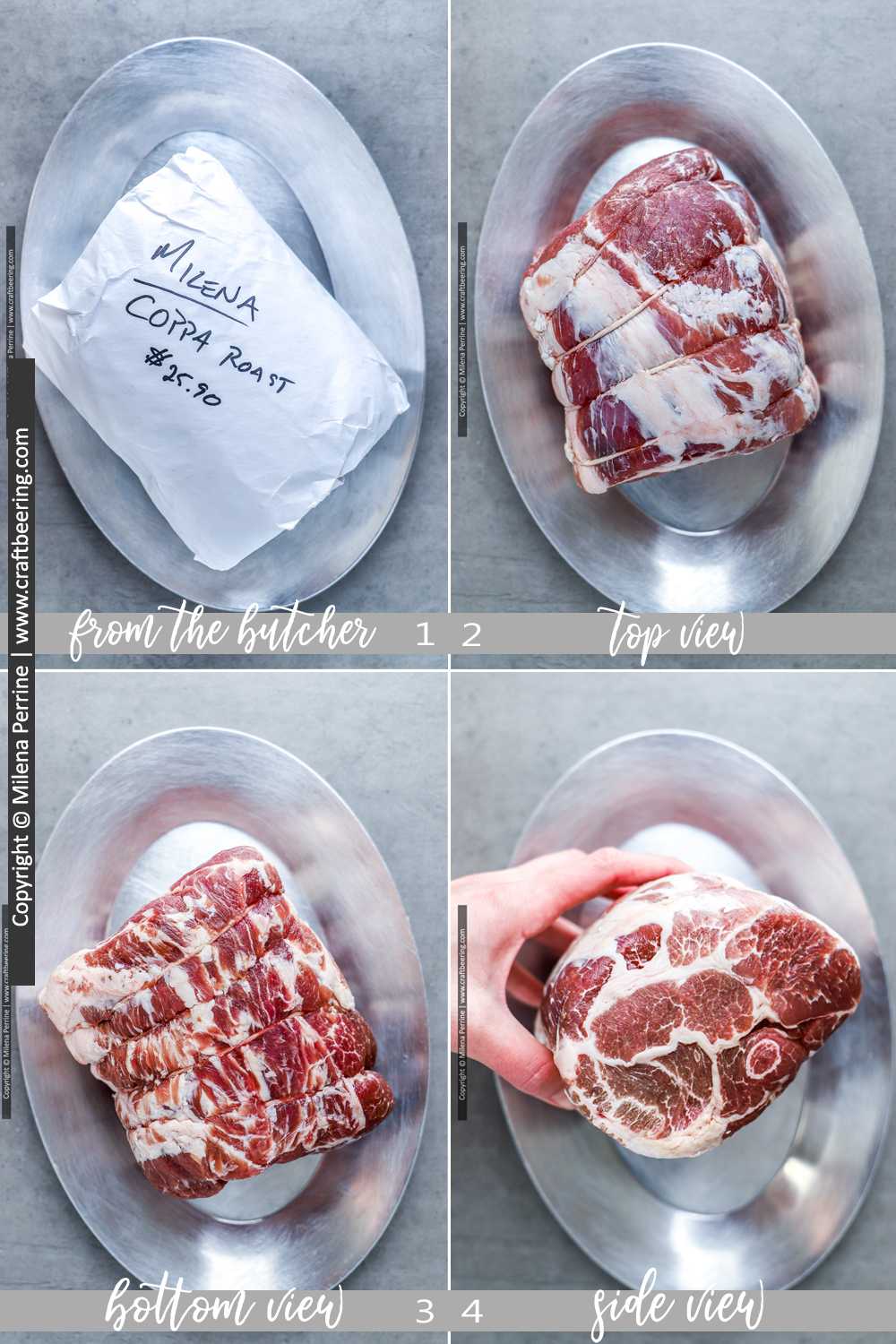
Our friendly small town butcher has a true passion for coppa roast – he never dissapoints us.
At the meat department in the grocery store pork collar can be called pork neck, top pork shoulder or coppa roast. Among dedicated butchers the name shoulder eye is a common way to refer to it. Only two of these cuts can be harvested per animal, one from each side.
Cured Coppa – The Italian Connection
When coppa is dry-cured it is transformed into a pork salami which is a world-wide favorite for Italian inspired sandwiches and charcutierie boards. The cold cut is known as capicola or copocollo, deriving from the Italian words for head (capo) and shoulder (collo).
It is also popular as bondiola in Argentina and Uruguay where Italian settlers have shaped the local cuisine.
Cured coppa is different from prosciutto, which comes from the legs and is essentially a cured ham and typically contains the bone.
What Does Coppa Meat Taste Like?
Frequently referred to as the money muscle by barbecue pulled pork afficionados, coppa pork neck has a rich porky flavor, stronger than any other part of the shoulder. It is endowed with generous marbling which amplifies the already intense taste as the fat melts during cooking.
Pork collar is easily one of the top three most flavorful parts of the hog in our opinion, right on par with pork belly and pork shanks.
The tenderness of the meat is driven by the breed and diet of the animal. To that end we really like the Berkshire pork collar sold by D’Artagnan (affiliate link) and recommend it if you cannot source the cut at local butcher shops.
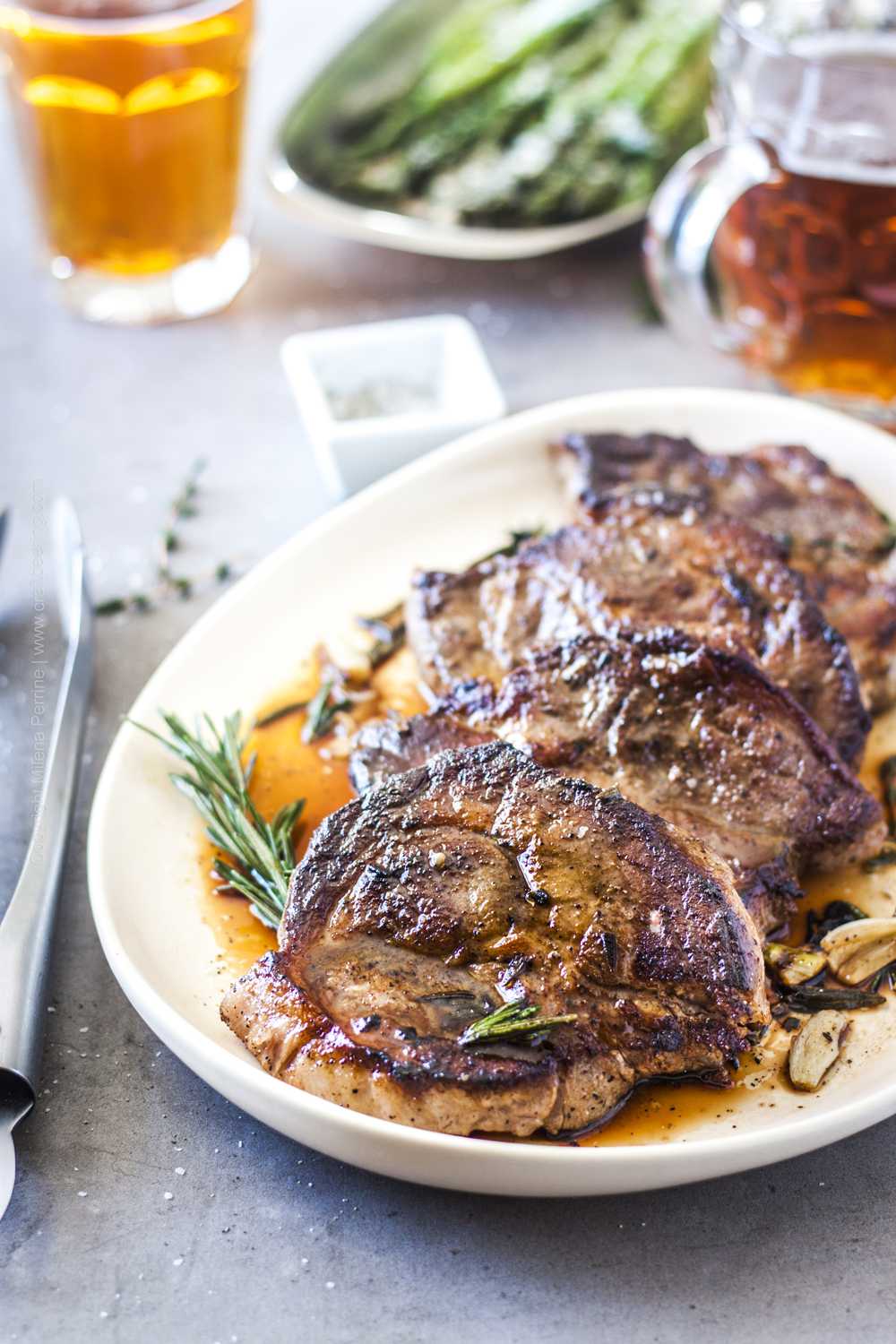
Pan seared coppa steaks are naturally juicy and tender, no brine is needed.
Top Ways to Cook Pork Collar
Slow roast it. Allowing the fat to slowly melt and both flavor and moisten the pork as it does so is at the center of the coppa roast recipe below.
Smoke it. For delectable pulled pork, the kind that wins the top prizes at barbecue competitions.
Grill it. Use the instructions below for a whole roast. If carved into chops like these, grilling pork collar is a breeze directly onto the grate.
Braise it for incredibly delicious, fall-apart-tender pork meat.
Pan sear it after you cut it into chops, here is a recipe.
Ingredients for Coppa Roast
Pork collar. This roast typically weighs between 3 and 4 pounds. If you are procuring it from your butcher, he will roll and tie it for you, but the meat will taste just as good if you purchase the trimmed whole muscle.
Spice rub or a pork marinade. You can go with a simple mixture of salt, black pepper, garlic powder and cumin or use your favorite pork rub. Other compatible flavors are caraway, onion, paprika, oregano. If you would rather mix a marinade – here are a few ideas.
Flavorful liquid. We add it to the pan to provide some moisture during the slow roasting. The pan juices resulting from it mixing with the drippings from the meat are excellent to convert into a gravy to serve with the roast. You can use stock, wine, a combination of both or – our favorite, beer. To that end we recommend a style that is malt centric and lightly hopped with low alpha acid hops, such as many German lagers (above and below shown is Munich Helles).
Onion. This is completely optional – in the event that you do not want to use a roasting rack, use thick onion slices to rest the roast upon while it is in the oven.
How to Cook Pork Collar (or Rolled Coppa Roast)
Be sure to bring the pork neck to room temperature before cooking.
NOTE: In order to brown the surface of the coppa before you begin cooking it you can either sear it in a hot pan or simply place it in a very hot oven for the first 25 minutes as shown above.
- Rub & prep. Make a spice blend/use your favorite and generously rub the pork neck on all sides. In the meantime preheat oven to 425 F.
- Roast. Place the meat inside the hot oven for 25 minutes, then take it out and lower the temperature to 325 F. Add your choice of liquid to the baking dish, loosely tent the meat with foil and place it back in the oven for 1 1/2 hours. After that time remove the foil and baste with the juices in the pan. Continue to slow roast uncovered.
Coppa Roast Cooking Time
The total roasting time for a coppa of about 3 pounds is just over 2 1/2 hours, but this depends on the calibration of your oven too.
Even though pork is food safe at 145 F internal temperature, you can allow the pork collar to exceed that and go all the way to 155 F. We normally pull it out around 148-150 F measured at the very center and it reaches 155 F as it continues to cook out of the oven. It is important to let the meat rest before you carve it. (If a rolled roast, remove the butcher’s twine before slicing.)
How to Grill Pork Collar
Slow roasting coppa meat on the grill, especially a charcoal grill, imparts more intense, rustic flavors.
You can use a large cast iron skillet or roasting pan you have dedicated for grill use. You want to capture all the delicious liquids that will ooze from the pork neck and use the them to baste it occasionally.
Grill with the lid closed to create a dry heat, oven-like environment. The steps are similar to traditional slow roasting.
- Prep. Heat your grill to 425F and prepare the roast as described above. Place the roasting pan or large skillet on the grill and cover.
- Grill. After 25 minutes open the grill and loosely tent the pork with foil. Add liquid to the pan, lower the temperature to 325 F. After 1 1/2 hours remove the foil and continue to cook, basting occasionally until the meat registers around 150F. Pull it out and let it rest.
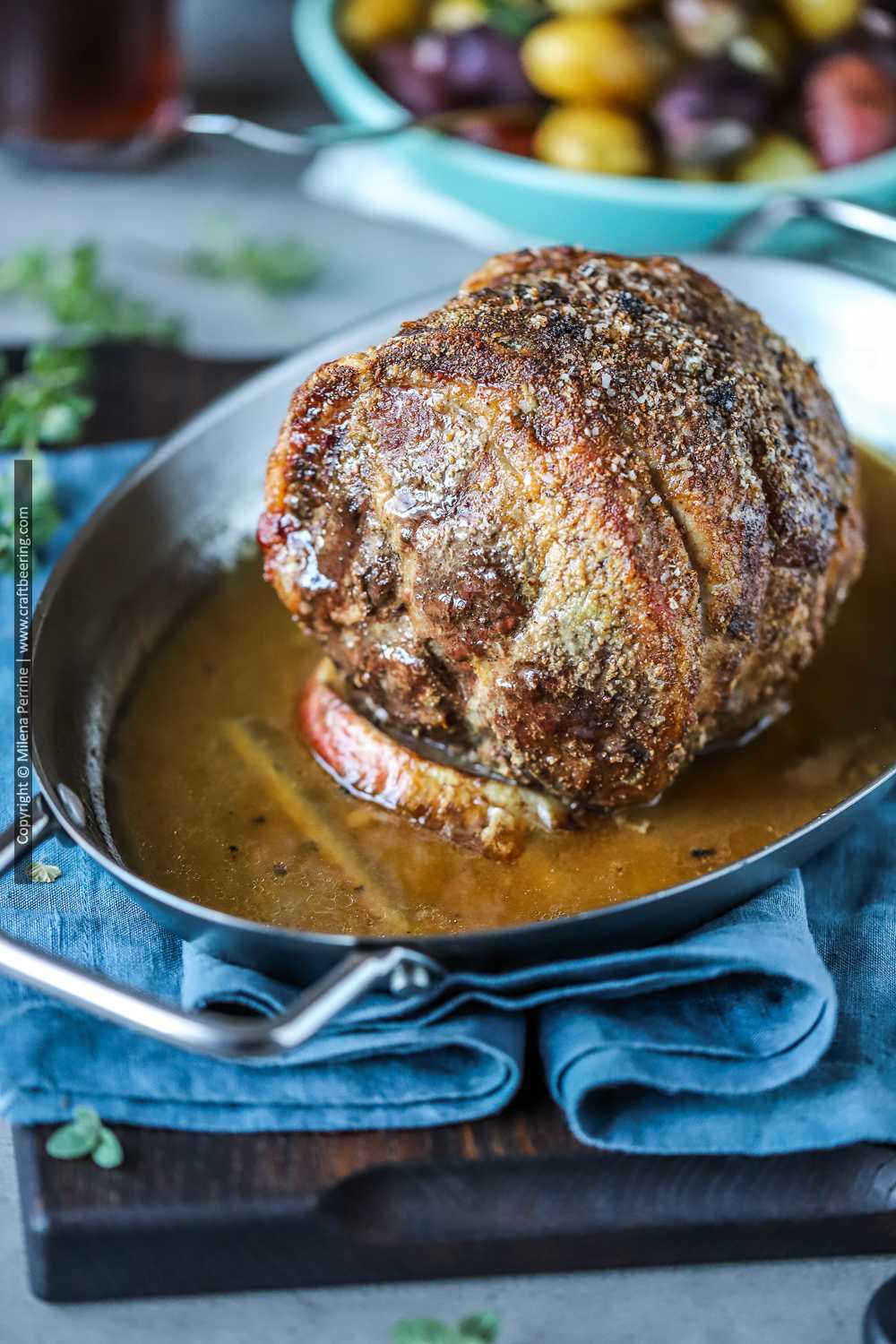
Be sure to rest the pork collar for 10 to 15 minutes before you carve it. You may tent it with foil to keep it warm.
Gravy from the Pan Liquids
If you would like to make a gravy from the pan drippings while the roast is resting simply follow the instructions in the recipe card below. The whole process won’t take much longer than 4-5 minutes.
Best Sides for Pork Neck Roast
Roasted pork neck is such a delicious protein to pair with a variety of side dishes.
Potatoes. From mashed or boiled potatoes with butter to crispy rosemary roasted potatoes
Rice. Whether simply boiled white rice or a rice pilaf, the grain is a wonderful side for pork collar.
Vegetables. Anything from roasted root vegetables to braised collared greens or simply sauteed broccolini will make a superb side for this cut of pork.
Cornbread, biscuits or apple chutney. We particulary like these Cathead Biscuits and this recipe for chutney with apples.
You Might Also Like
Grilled Pork Coppa Steaks
Pork Collar Chops
Boneless Pork Shoulder Roast with Crackling
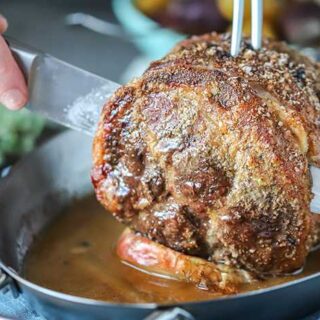
Coppa Meat Roast (Pork Collar Roast)
How to cook pork neck as a roast in the oven or on the grill. Enjoy flavorful, tender meat with minimal effort. Depending on the size and weight of your cut this recipe yields 4 to 6 servings. Account for the fact that a heavier piece of meat will take longer to cook.
Ingredients
Coppa Roast
- 3-4 lbs pork collar (aka coppa roast), trimmed or rolled and tied
- 1 1/2 tbps dry rub (2 tsp kosher salt, 1 tsp ground pepper, 1 1/2 tsp garlic powder, 1 1/2 tsp cumin)*
- 12 oz beer (or chicken or beef stock, or half and half stock and wine)**
- 1 onion (optional) to use as base to lay the roast on top in the absence of a roasting rack.
Gravy
- 1 tbsp butter
- 1 tbsp AP flour
- 1 cup pan drippings***
- Salt and pepper, to taste
Instructions
If using a pork marinade (see link below for recipe suggestions) mix it and marinate the coppa overnight. (You will only need to season with salt and pepper once out of the marinade).
Bring the pork to room temperature before you begin to cook it.
OVEN
- Preheat oven to 425F.
- Mix a dry rub by combining the seasonings (or use your favorite) and generously coat the coppa meat all over. Place it in a pan equiped with roasting rack. Alternatively, cut two thick onion slices, place them in a roasting pan and position the seasoned pork collar on top.
- Cook for 25 minutes and take it out of the oven (see pictures in post above). Lower the temperature to 325F. Add beer or stock to the pan, loosely tent the pork with foil and return it to the oven for 1 1/2 hrs at the lower temperature.
- After that time remove the foil, baste the pork with the pan juices and let it continue cooking uncovered, still at 325 F. You may add extra stock or water to the pan if needed.
- After thirty minutes or so check the temperature at the center of the roast. You are looking for 145 F to 155 F. Keep in mind it will continue to cook once out of the oven, so 148-150F is ideal.
- Allow the pork to rest, if a rolled roast remove the twine. You may loosely tent it with foil while resting.
GRILL
- Preheat grill to 425F.
- Apply rub to the pork collar as per above instructions, place it in an appropriately sized cast iron skillet with two onion slices underneath the roast (or use a dedicated pan for the grill).
- Cook with the grill lid closed, maintaining the 425F temperature for 25 minutes or so.
- Lower the grill temperature to 325F, add beer or stock to the skillet/pan, tent the coppa with foil and cook for another 1 1/2 hours.
- Remove the foil, baste with the drippings and continue to cook until the internal temperature registers 145F-155F when measured in the center. Keep in mind it will continue to cook away from the heat, so 148-150F is ideal before you allow it to rest.
GRAVY
While the pork collar is resting, heat a saucepan over medium heat. Melt the butter, add the flour and whisk it in. While continuing to whisk add the drippings from the pan. Taste and season with salt and pepper if needed.
Once the gravy has reached your desired thickness, transfer it to a serving dish. You may add liquid to thin it out if necessary.
Notes
*Simply a suggestion. Use your favorite dry rub for pork or mix your own. You may need a bit more if your roast is on the larger size.
Alternatively, you can marinate the pork collar overnight before you roast it. Here are ideas for Pork Marinades.
**A German style lager, whether golden, amber or dark would be perfect in this recipe. The herbal notes of the hops, their low bitterness and the malty nuances are just the partner for the intense flavors of the coppa drippings and together create an excellent flavor profile for a gravy.
***If you do not have enough, add stock to make up the difference.
Recommended Products
We are affiliates for Amazon and other vendors and qualifying purchases you make support our blog at no cost to you.
Nutrition Information:
Yield: 4 Serving Size: 1Amount Per Serving: Calories: 881Total Fat: 50gSaturated Fat: 18gTrans Fat: 0gUnsaturated Fat: 26gCholesterol: 307mgSodium: 294mgCarbohydrates: 5gFiber: 0gSugar: 0gProtein: 90g
Based on 3 lbs pork collar.

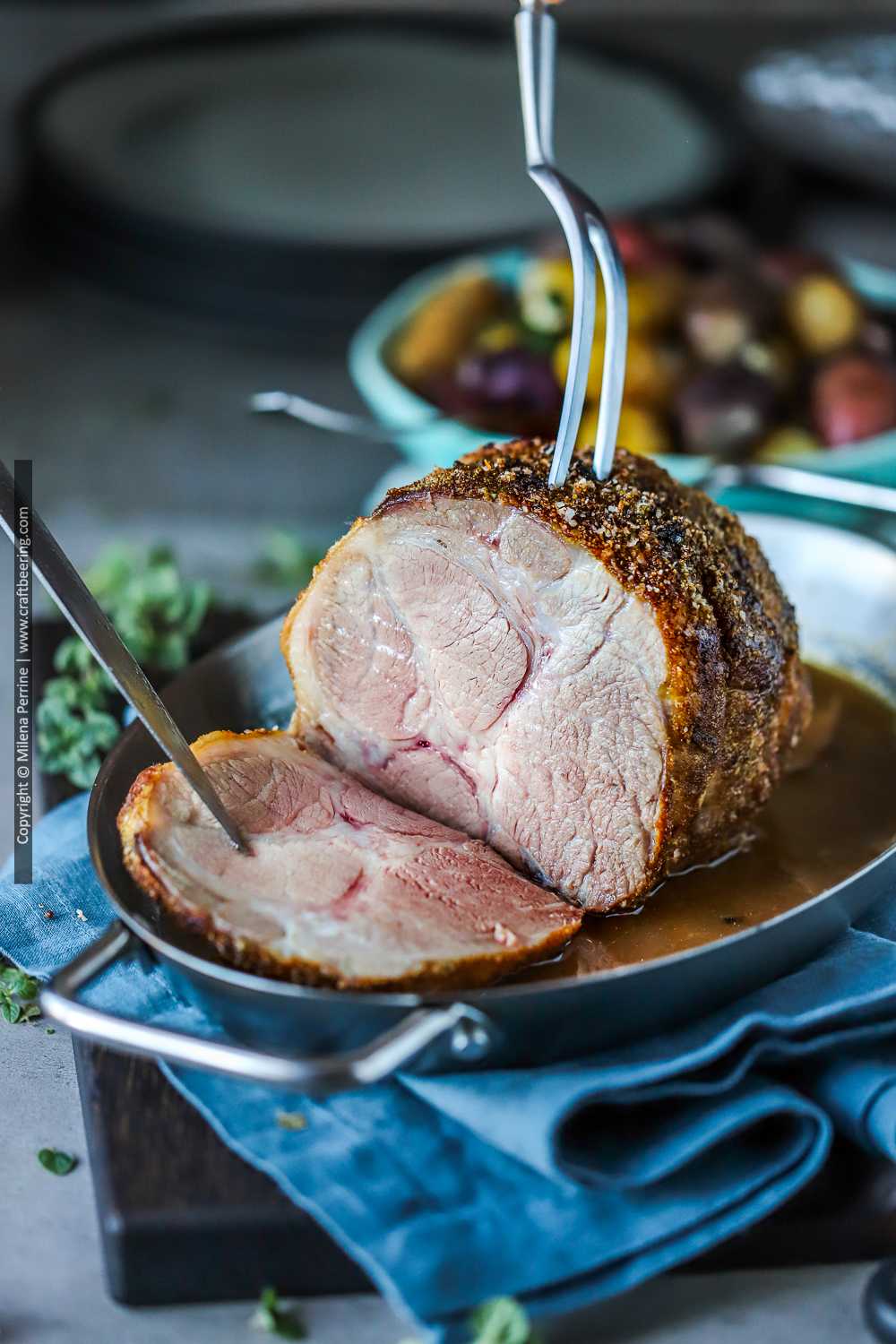
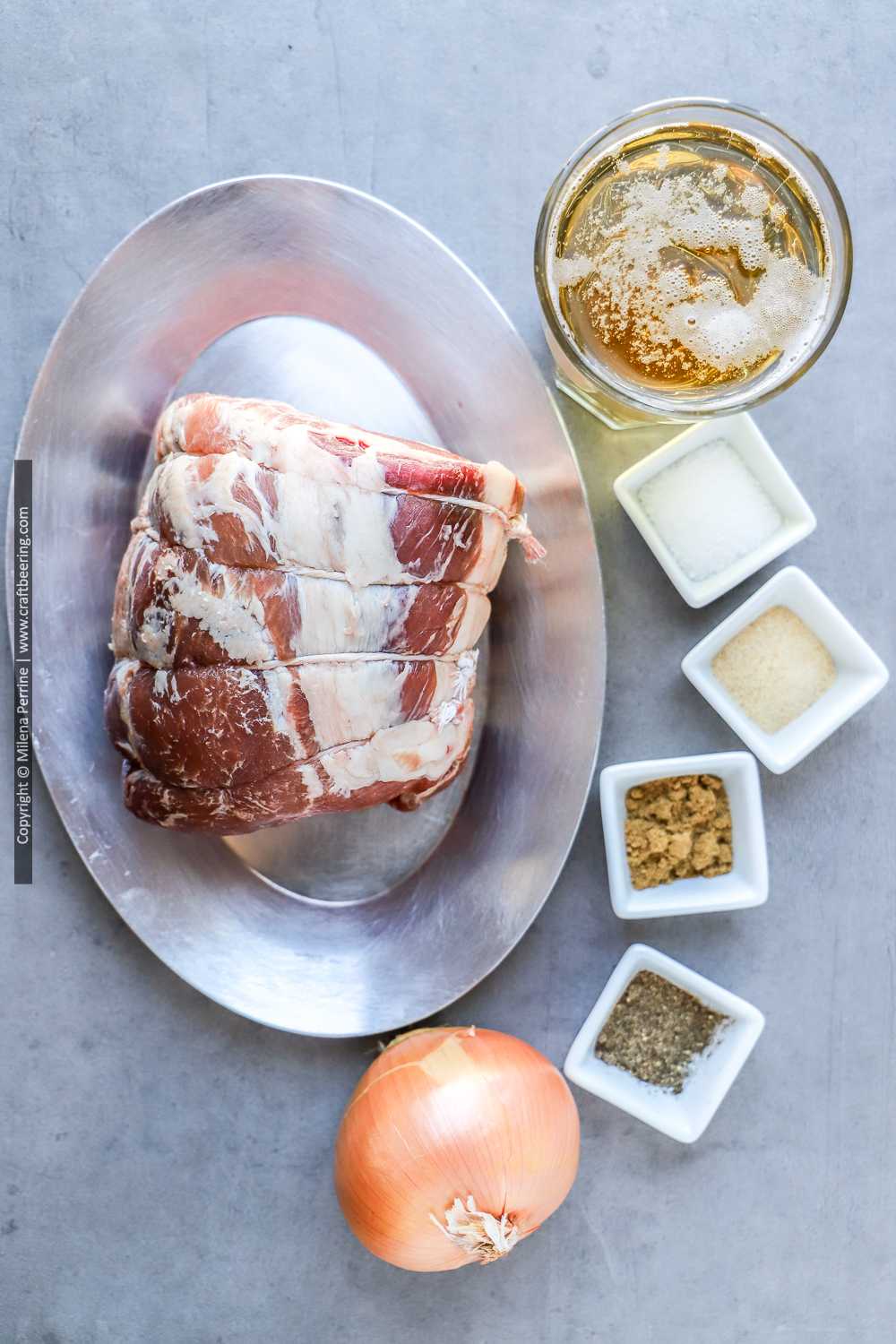
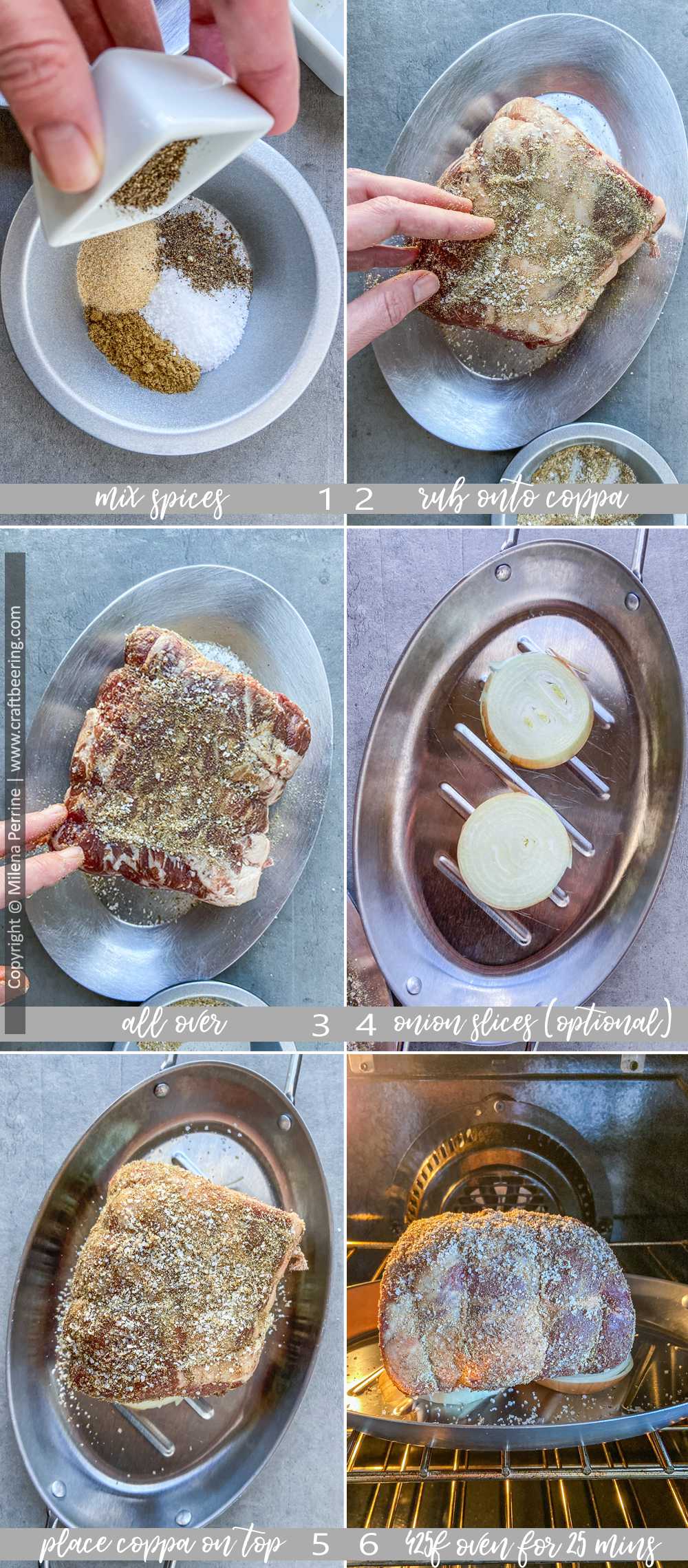
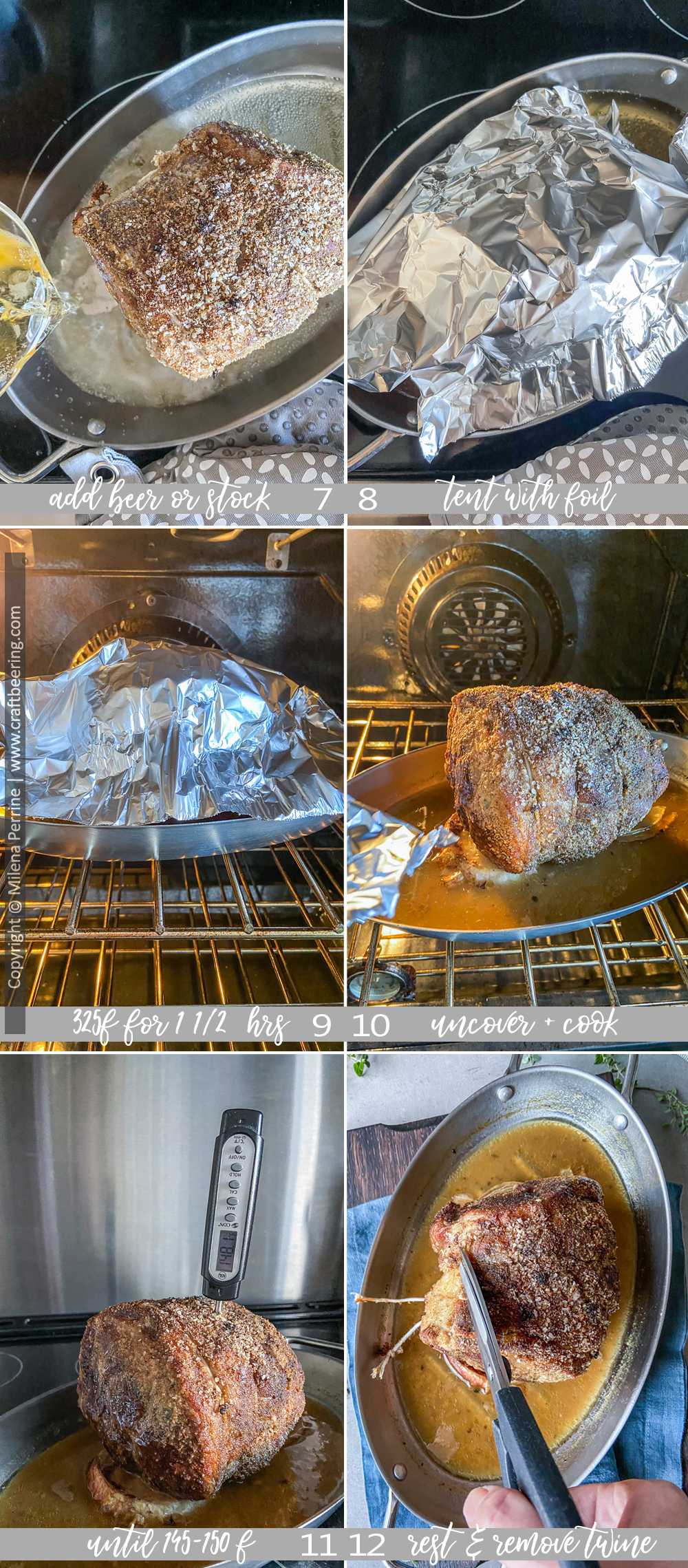
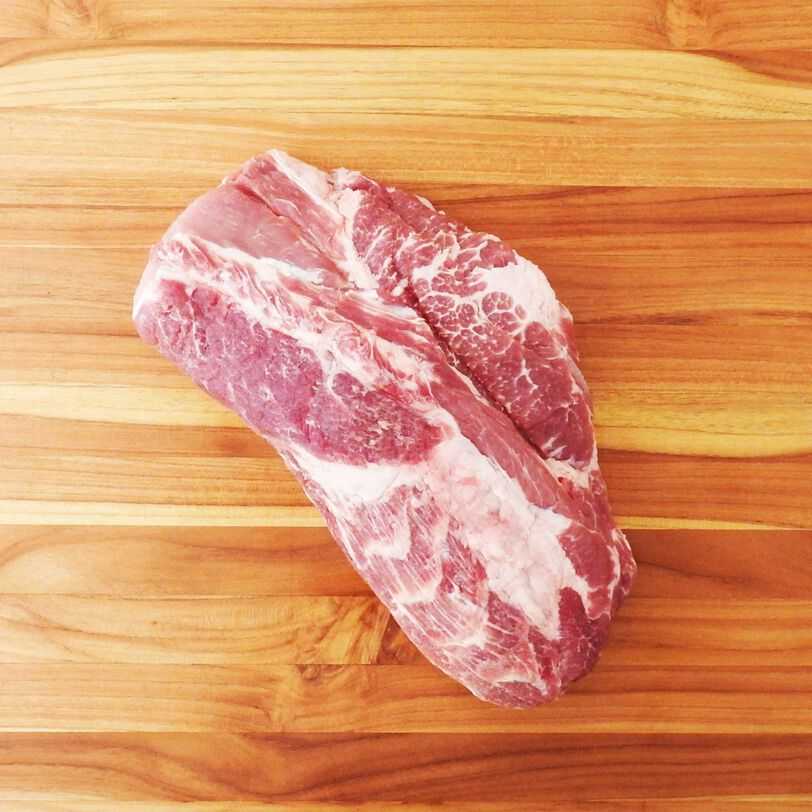
Charles Blaquière says
If my roast is 1.5 pounds, how would I adjust the cooking time for each step?
Milena Perrine says
Cahrles, I would do 12-14 mins at 425F, then about an hour at 325F tented with foil and then check the temperature to determine how much longer (20 mins to 30 mins likely). Towards the end rely on your meat thermometer readings and also a fork probe and your own senses to get a feeling of how tender it has become and if it needs a bit longer at low (you can even turn down the heat to 275-300 F at the very end if you decided to leave it for a few more minutes.